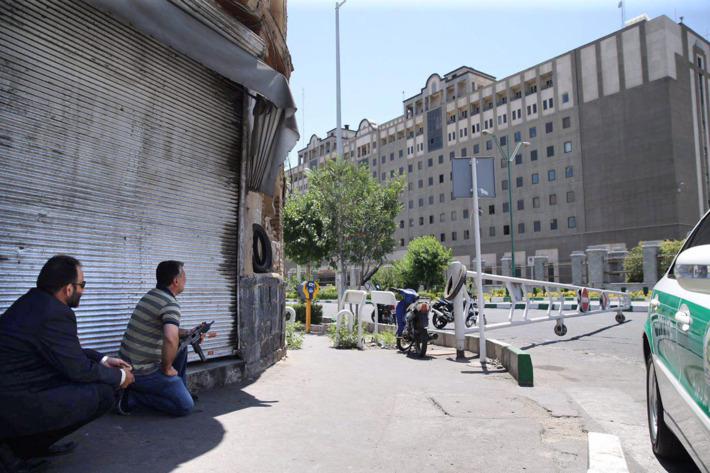Riyadh – The attack launched by ISIS against Iran’s parliament and Khomeini Mausoleum have raised many questions over their timing because the terrorist group had, since its establishment, never targeted the country.
This could indicate a strategic shift by ISIS to attack Iranian political and religious targets in a violation of an al-Qaeda demand that Tehran be kept away from the unrest. This shift is likely given the terror group’s losses in Iraq and Syria, which has prompted it to carry out attacks all over the world.
The world itself is the enemy of ISIS and the Tehran and London assaults were staged during Ramadan, which is the latest victim of the group that has for years intensified its attacks during this holy month.
The organization has always chosen religious occasions to launch attacks due to the large number of casualties it will be able to score, such as what happened against the Copts in Egypt when they were celebrating Easter.
Ramadan, a month of patience and worship, was used by ISIS to spur sympathizers and supporters to carry out attacks. In May 2016, former ISIS spokesman Abou Mohammd al-Adnani called at the advent of Ramadan supporters to stage attacks in Europe, urging them “to prepare themselves to make this month of plight everywhere against all infidels.”
Supporters complied with the call, staging attacks at Istanbul’s Ataturk airport, three others in Saudi Arabia and several in Iraq.
For a long time, it seemed that Iran was not on the agenda of terrorist assaults, starting from al-Qaeda and reaching ISIS. Iran was never targeted by these groups even though they are at opposite ends of the sectarian spectrum. The confrontation between the two sides was limited to the Iraqi and Syrian battlegrounds.
The last time Iran was victim to a terrorist attack was in October 2009 when 29 people were killed in twin bombings claimed by the Baluchi Sunni Jamaa Jundallah group that targeted a meeting of Iranian Revolutionary Guards officials. A year earlier, 14 people were killed and over 200 wounded in an attack against al-Hassanein mosque in Shiraz. It was claimed by the obscure Soldiers of the Kingdom Assembly of Iran group.
This has made analysts skeptical that ISIS may begin targeting Iran, despite a March 2017 recording by the group in which it vowed to threaten its security, accusing it of “oppressing Sunni Muslims.”
ISIS not al-Qaeda
The role of ISIS in Iraq came to prominence when it used sectarian slogans to spur Sunni Muslims to rise against the evil of what it called the “traitors” and “Iran agents.” It also criminalized Arab and Muslim regimes and turned the world into its enemy seeing as it believes that only its adherents are on the right path.
The differences between it and al-Qaeda also came to light in that the latter focused on targeting western countries alone and avoided Iran and Shi’ites in Iraq. The thorny relationship between Iran and extremist Sunni organizations are made clear through a statement by Abou Adnani, who rejected in a May 2014 recording the policy of al-Qaeda that had advised ISIS against targeting Shi’ites and Iran.
ISIS committed to this demand and left the “infidels” safe in Iran, “while it could have turned the country into pools of blood,” he said at the time.
ISIS “has for years reined in its soldiers, withstanding accusations that it was cooperating with its greatest of enemies in Iran because it has not targeted it,” he added.
He said that ISIS committed to al-Qaeda who sought to preserve its interests and supply routes in Iran.
The former ISIS spokesman sought with his statements to refute accusations that his organizations has ties with Iran, which would contradict with the very foundations of the group that deems Shi’ites as traitors.
Questions should therefore be raised over the reason and timing of the Tehran attacks. Abou Adnani’s statements were a rebellion against al-Qaeda, which was like the mentor of ISIS and a part of it before the latter became its own independent entity.
Abou Adnani, who was killed in Aleppo, was succeeded by Abou al-Hassan al-Mouhajer, who also made threats against Iran, blaming it for the plight of Sunnis in Iraq and Syria.
Strategic Need
Attacking Iran has become a “strategic need” for the terrorist group after its failure to establish the so-called “caliphate” in each of Iraq and Syria and after several of its leaders fled Mosul. Targeting Iran will be seen as a success that will cover its series of defeats and counter Tehran’s growing power in Iraq and Syria where it has raised the number of Shi’ite militias. Several of these militias were formed to combat ISIS, but many have attacked Sunnis in Iraq without discriminating between extremist and civilian. This has stoked the sectarianism that ISIS had initially created.
It has generally become easier for ISIS to carry out attacks in countries outside of the region after the international coalition wore it down with its land and air operations in Iraq and Syria. These attacks are also easier to execute because they are arbitrary and an act of revenge against all who were involved in targeting the group.
It is no easy feat for the organization to keep staging attacks beyond regional bordered given the heightened security in those countries, which shows the extent that ISIS has infiltrated them.
It is difficult to predict whether ISIS will repeat its attacks in Iran, while the Iranian Revolutionary Guards vowed to pursue those behind the attacks.
US President Donald Trump’s statement on the issue demonstrated the mystery that surrounds Iran’s ties with terrorist groups. He expressed his sympathy with the people, but added that the sponsors of terrorism had now fallen victim to it, sparking Iranian condemnation.
